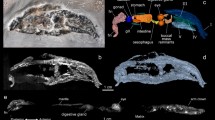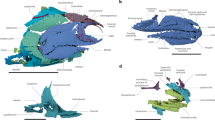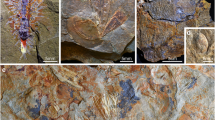Abstract
During the past 50 years, X-ray examinations have greatly increased our knowledge of fossils. Modern radiographic methods, X-ray tubes with fine focal spots, high-resolution films and optimal exposure conditions have revealed details of the anatomy and general biology of ancient life as well as species and representatives of major groups hitherto unknown in the Lower Devonian1–5. Most of this material came from the Hunsriick slate, where most fossils are converted to pyrite, FeS2, giving a good contrast in the radiographs. Additional image processing may reveal even more details. While screening large quantities of black slate pieces, I have discovered a small teuthid coleoid showing soft parts (Fig. 1) which is the best-preserved specimen I have found during 20 years of investigation. This Eoteuthtis elfriedae n.sp. is very similar to the living Alloteuthis africana of the Loliginidae, and is one of many unusual fossils yielded by this slate3–5, only a few of which have been published. This specimen of E. elfridea shows that Alloteuthis-like animals have not changed much over the past 400 Myr, and means that previous concepts of the appearance of such forms must be revised.
This is a preview of subscription content, access via your institution
Access options
Subscribe to this journal
Receive 51 print issues and online access
$199.00 per year
only $3.90 per issue
Buy this article
- Purchase on SpringerLink
- Instant access to full article PDF
Prices may be subject to local taxes which are calculated during checkout
Similar content being viewed by others
References
Fischer, J. C. & Riou, B. C.r. hebd. Séanc. Acad. Sci., Paris 295, 277–280 (1982).
Johnson, R. G. & Richardson, E. S. Jr Science 159, 526–528 (1968).
Stanley, G. D. Jr & Stürmer, W. Nature 303, 518–520 (1983).
Stürmer, W. Science 170, 1300 (1970).
Stürmer, W. Interdisc. Sci. Rev. 9, 123 (1984).
Termier, H. & Termier, G. Ann. Soc. Geol. Nord 3, 109–112 (1970).
Roper, C. F., Young, R. E. & Voss, G. L. Smithson. Contr. 13, 1–32 (1969).
Bandel, K. Paleont. Z. 57, 271–284 (1983).
Donovan, T. D. Symp. zool. Soc. Lond. 38, 15–48 (1977).
Dzik, J. Acta palaeont. pol. 26, 161–189 (1981).
Morton, J. E. & Yonge, C. M. in Physiology of Mollusca Vol. 6 (eds Wilbur, K. M. & Yonge, G. M. 47–57 (Academic, New York, 1964).
Naef, A. Die fossilen Tintenfische (ed. Fischer, G.) (G. Fischer, Jena, 1922).
Voss, G. L. Symp. zool Soc. Lond. 38, 49–60 (1977).
Chen, Yun-Yuan & Teichert, C. Geology 2, 647–650 (1983).
Author information
Authors and Affiliations
Rights and permissions
About this article
Cite this article
Stürmer, W. A small coleoid cephalopod with soft parts from the lower Devonian discovered using radiography. Nature 318, 53–55 (1985). https://doi.org/10.1038/318053a0
Received:
Accepted:
Published:
Issue date:
DOI: https://doi.org/10.1038/318053a0
This article is cited by
-
The size of the siphuncle in cephalopod evolution
Senckenbergiana Lethaea (2003)
-
Supposed soft tissue preservation in the Hunsrückschiefer (Lower Devonian, Rheinisches Schiefergebirge): the example of brachiopods
Paläontologische Zeitschrift (2000)
-
Marine biology: Stunning whales and deaf squids
Nature (1986)



